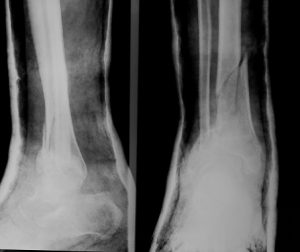
Lead research Dr. Brent Richards said, “EN1 has never before been linked to osteoporosis in humans, so this opens up a brand new pathway to pursue in developing drugs to block the disease.” Supplementing author Vince Forgetta added, “The effect of this uncommon genetic variant that we identified in this gene is twice as large as any previously identified genetic variants for BMD and fracture.”
Osteoporosis typically affects older women, but men can develop it as well. As a common bone disease, osteoporosis increases the risk of bone fractures as bone mineral density decreases over time, making them frail. As the population continues to age, osteoporosis is becoming more prevalent.
The UK10K measured genetic variants from 10,000 individuals in great detail. Researchers were then able to correlate rare genetic changes with human disease by comparing DNA of healthy individuals to those who have health problems.
Senior investigator Dr. Celia Greenwood said, “The hypothesis is that the genetic sequencing being done by UK10K will expose previously unknown genetic factors underlying disease. We are finally able to extract enough data to discern variants that are rare in the overall population and are more frequent among those with common diseases. This is precisely what has been revealed in the case of EN1 and osteoporosis.”
Role of genes in osteoporosis
Osteoporosis-related genes are grouped in three biological pathways: Estrogen endocrine pathway, the Wnt/β‐catenin signaling pathway and the RANKL/RANK/OPG pathway. Both common and rare genes can contribute to the development of osteoporosis.
Other risk factors that can cause osteoporosis
Genes are not solely to blame for the cause of osteoporosis; there are other factors as well which can lead to osteoporosis. Osteoporosis is the loss of bone mass. For example, being deficient or not consuming enough calcium can contribute to loss of bone mass, which then contributes to osteoporosis. Additionally, a deficiency in vitamin D can contribute to loss of bone mass because – in order for calcium to be properly absorbed into the bones – vitamin D is required.
For aging women a drop in estrogen, too, can contribute to the development of osteoporosis. Bone loss is often accelerated during menopause due to a drop in estrogen. For men, osteoporosis can be caused by a drop in testosterone. Testosterone is required to convert into estrogen for strong bones. A drop in testosterone means less estrogen which results in weaker bones.
Hormone imbalances, like parathyroid hormone and growth hormone can also contribute to the development of osteoporosis. These hormones are necessary in determining how well your bones will use calcium. If an imbalance is present, calcium may not be properly absorbed, thus resulting in loss of bone mass.
Lack of physical activity, or a sedentary lifestyle, can also play a role in osteoporosis. When we exercise – especially performing weight-bearing exercises – it causes minor breaks in the bone which, when healed, lead to stronger bones. When this gentle stress is not put on our bones because we are not moving, it can result in weak bones which increases the risk of fractures.
Smoking, too, can weaken bones, according to some research. Research shows nicotine has harmful effects on bones and inhibits the body’s ability to use estrogen to make strong bones. Other research shows smokers have weaker bones when compared to nonsmokers.
Lastly, alcohol can result in calcium loss which can diminish bone mass. Additionally, being tipsy impairs balance which raises the risk of falls and fractures.
Many of the risk factors which cause osteoporosis are controllable, so you can start to embark on healthier habits as a means to prevent osteoporosis.
Improving bone mineral density to prevent osteoporosis
Not only is it a wise idea to follow the above suggestions to help reduce your risk of developing osteoporosis, but at the same time you should work on improving bone mineral density to prevent osteoporosis.
Below are some effective tips to improve bone density as a way to prevent osteoporosis.
- Ensure your are taking in adequate calcium*
- Eat fruits and vegetables
- Minimize salt, alcohol and caffeine consumption
- Quit smoking, or don’t start
- Exercise
- Ensure you are getting adequate magnesium and potassium*
- Ensure you are getting adequate vitamin D and vitamin K*
- Get your estrogen and testosterone levels checked
- Know your family history
- Reduce your risk of falls
*Always speak to your doctor prior to beginning supplementation of vitamins.
Related Reading:
Exercise benefits of osteoporosis: Reduces bone fracture risk
Over 50 million Americans are affected by osteoporosis and bone fractures, making prevention methods a focus and putting exercise benefits in the spotlight. The study, conducted through a special mapping technique at the University of Cambridge, demonstrated that just two minutes of hopping per day could strengthen hip bones and reduce the risk of fractures after a fall. Continue reading…
Study: Heart disease linked to osteoporosis in elderly
We all know seniors are at greater risk for heart disease as well. Risk factors of heart disease include smoking, high cholesterol, high blood pressure and inflammation of the blood vessels. But a potential new risk of heart disease has just been discovered. In fact it has to do with osteoporosis. Continue reading…
Sources:
http://www.eurekalert.org/pub_releases/2015-09
http://www.els.net/WileyCDA
http://www.nih.gov/researchmatters/april2012
http://www.webmd.com/osteoporosis/living-with-osteoporosis-7/causes
http://www.mayoclinic.org/diseases-conditions/osteoporosis/basics/causes
//www.belmarrahealth.com/7-quick-tips-to-improve-your-bone-density
http://www.healthline.com/health-slideshow/build-strong-bones